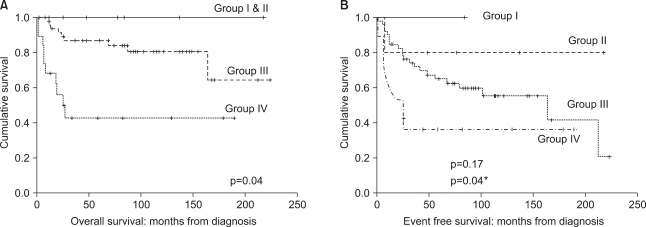Cancer Res Treat.
2008 Sep;40(3):111-115.
Initial Response to Treatment was Highly Associated with the Prognosis of Childhood Rhabdomyosarcoma: A Retrospective Analysis of a Single Center Experience in Korea
- Affiliations
-
- 1Department of Pediatrics and Cancer Research Institute, Seoul National University College of Medicine, Seoul, Korea. hyshin@snu.ac.kr
- 2Department of Therapeutic Radiology, Seoul National University College of Medicine, Seoul, Korea.
- 3Department of Pediatric Hematology and Oncology, Asan Medical Center, Seoul, Korea.
Abstract
-
PURPOSE: Following the introduction of a multimodal approach to diagnosis and treatment, the prognosis of rhabdomyosarcoma (RMS) has markedly improved over the last three decades. However, there are few data on treatment outcomes in Korean patients.
MATERIALS AND METHODS
We performed a retrospective analysis of 77 patients with RMS diagnosed and treated at Seoul National University Children's Hospital between 1986 and 2005.
RESULTS
The overall 5-year survival and event-free survival rates for all patients were 77% and 59%, respectively. The Intergroup Rhabdomyosarcoma Study clinical grouping and initial response to treatment (20-week response) were important prognostic factors.
CONCLUSIONS
The outcome of childhood RMS was closely associated with the initial staging and the initial response to treatment. Modulating therapies according to initial responses and risk factors is critical, and new treatment strategies for high-risk patients are needed.
Keyword
MeSH Terms
Figure
Reference
-
1. Crist WM, Kun LE. Common solid tumors of childhood. N Engl J Med. 1991; 324:461–471. PMID: 1988832.
Article2. La Quaglia MP, Heller G, Ghavimi F, Casper ES, Vlaims V, Hajdu S, et al. The effect of age at diagnosis on outcome in rhabdomyosarcoma. Cancer. 1994; 73:109–117. PMID: 8275414.
Article3. Joshi D, Anderson JR, Paidas C, Breneman J, Parham DM, Crist W. Age is an independent prognostic factor in rhabdomyosarcoma; A report from the soft tissue sarcoma committee of the children's oncology group. Pediatr Blood Cancer. 2004; 42:64–73. PMID: 14752797.
Article4. Kim JM, Shin MK, Paik SY, Kim IS. An immunohistochemical study on differential diagnosis of small round cell tumor. J Korean Cancer Assoc. 1990; 22:48–61.5. Maurer HM, Beltangady M, Gehan EA, Crist W, Hammond D, Hays DM, et al. The Intergroup Rhabdomyosarcoma Study-I. A final report. Cancer. 1988; 61:209–220. PMID: 3275486.6. Crist W, Gehan EA, Ragab AH, Dickman PS, Donaldson SS, Fryer C, et al. The Third Intergroup Rhabdomyosarcoma Study. J Clin Oncol. 1995; 13:610–630. PMID: 7884423.
Article7. Kung FH, Desai SJ, Dickerman JD, Goorin AM, Harris MB, Inoue S, et al. Ifosfamide/carboplatin/etoposide (ICE) for recurrent malignant solid tumors of childhood: a Pediatric Oncology Group Phase I/II study. J Pediatr Hematol Oncol. 1995; 17:265–269. PMID: 7620926.8. Kaplan E, Meier P. Nonparametric estimation from incomplete observation. J Am Stat Assoc. 1958; 53:457–481.9. Peto R, Pike MC, Armitage P, Breslow NE, Cox DR, Howard SV, et al. Design and analysis of randomized clinical trials requiring prolonged observation of each patient. II. analysis and examples. Br J Cancer. 1977; 35:1–39. PMID: 831755.
Article10. Cox DR. Regression models and life tables. J R Stat Soc. 1972; 34:187–220.11. Koscielniak E, Harms D, Henze G, Jurgens H, Gadner H, Herbst M, et al. Results of treatment for soft tissue sarcoma in childhood and adolescence: a final report of the German Cooperative Soft Tissue Sarcoma Study CWS-86. J Clin Oncol. 1999; 17:3706–3719. PMID: 10577842.
Article12. Wharam MD, Meza J, Anderson J, Breneman JC, Donaldson SS, Fitzgerald TJ, et al. Failure pattern and factors predictive of local failure in rhabdomyosarcoma: a report of group III patients on the third Intergroup Rhabdomyosarcoma Study. J Clin Oncol. 2004; 22:1902–1908. PMID: 15143083.
Article13. Punyko JA, Mertens AC, Baker KS, Ness KK, Robison LL, Gurney JG. Long-term survival probabilities for childhood rhabdomyosarcoma. A population-based evaluation. Cancer. 2005; 103:1475–1483. PMID: 15712283.14. Kim YJ, Seo JJ, Moon HN, Ghim TT. Improved treatment result of childhood rhabdomyosarcoma: a single institutional study. Korean J Pediatr Hematol-Oncol. 2001; 8:58–66.15. Burke M, Anderson JR, Kao SC, Rodeberg D, Qualman SJ, Wolden SL, et al. Assessment of response to induction therapy and its influence on 5-year failure-free survival in group III rhabdomyosarcoma: the Intergroup Rhabdomyosarcoma Study-IV experience-a report from the Soft Tissue Sarcoma Committee of the Children's Oncology Group. J Clin Oncol. 2007; 25:4909–4913. PMID: 17971587.
Article16. Blay JY, Bouhour D, Ray-Coquard I, Dumontet C, Philip T, Biron P. High-dose chemotherapy with autologous hematopoietic stem-cell transplantation for advanced soft tissue sarcoma in adults. J Clin Oncol. 2000; 18:3643–3650. PMID: 11054437.
Article17. Carli M, Colombatti R, Oberlin O, Stevens M, Masiero L, Frascella E, et al. High-dose melphalan with autologous stemcell rescue in metastatic rhabdomyosarcoma. J Clin Oncol. 1999; 17:2796–2803. PMID: 10561355.
Article18. Lafay-Cousin L, Hartmann , Plouvier P, Mechinaud F, Boutard P, Oberlin O. High-dose thiotepa and hematopoietic stem cell transplantation in pediatric malignant mesenchymal tumors: a phase II study. Bone Marrow Transplant. 2000; 26:627–632. PMID: 11035368.
Article19. Koscielniak E, Klingebiel TH, Peters C, Hermann J, Burdach ST, Bender-Gotze C, et al. Do patients with metastatic and recurrent rhabdomyosarcoma benefit from high-dose therapy with hematopoietic rescue? Report of the German/Austrian Pediatric Bone Marrow Transplantation Group. Bone Marrow Transplant. 1997; 19:227–231. PMID: 9028550.
Article20. Carli M, Colombatti R, Oberlin O, Bisogno G, Treuner J, Koscielniak E, et al. European intergroup studies (MMT4-89 and MMT4-91) on childhood metastatic rhabdomyosarcoma: final results and analysis of prognostic factors. J Clin Oncol. 2004; 22:4787–4794. PMID: 15570080.
Article



